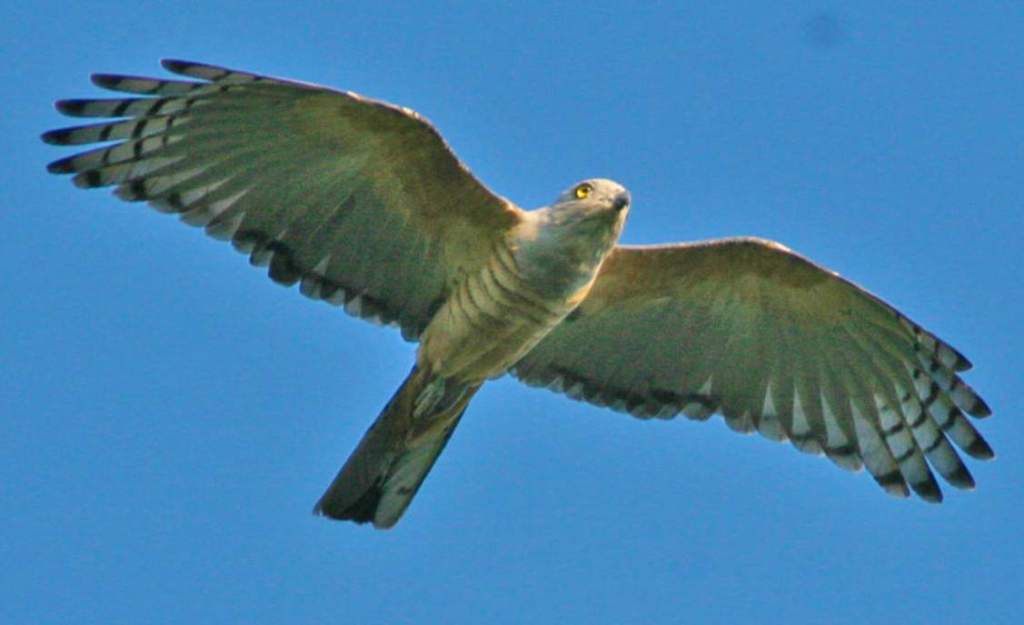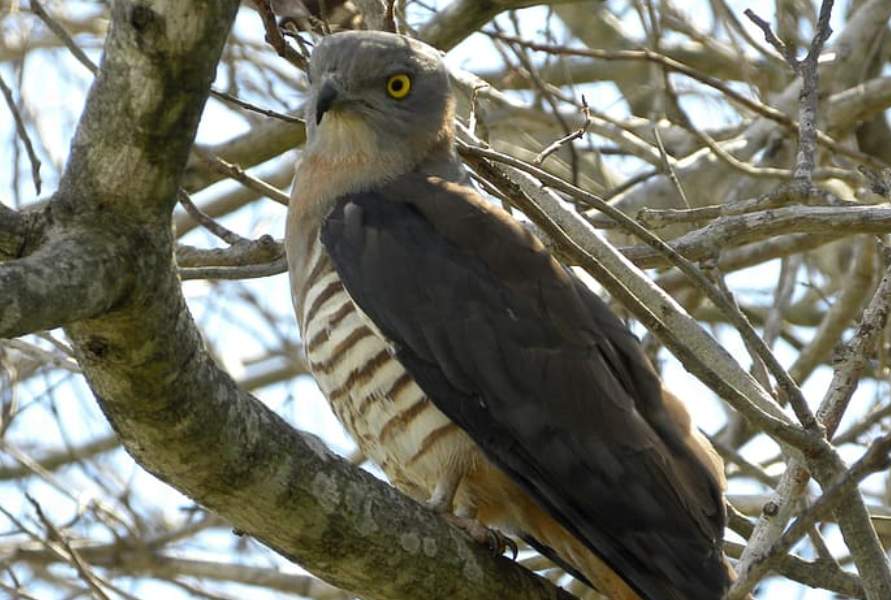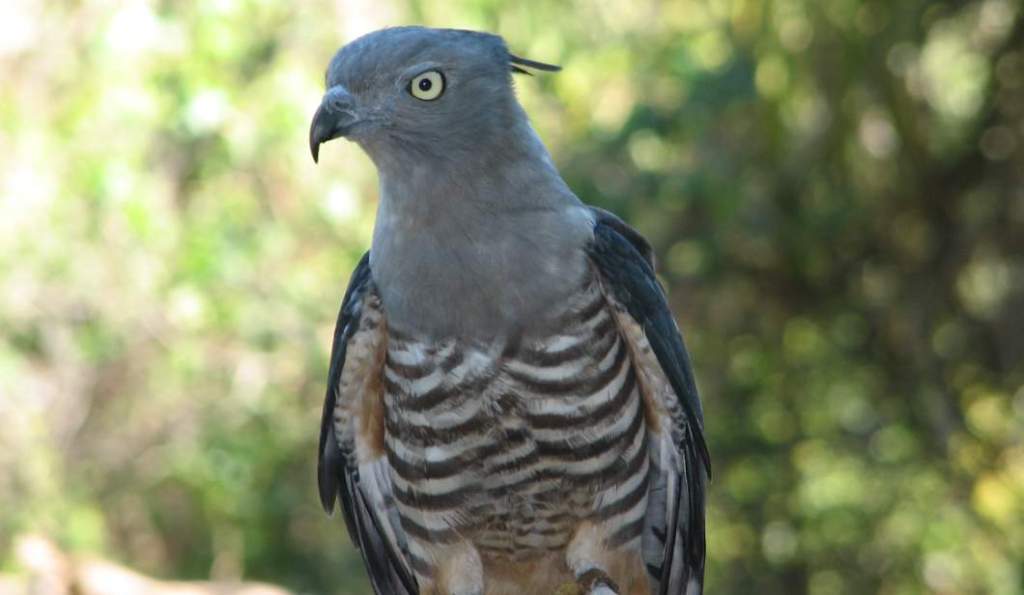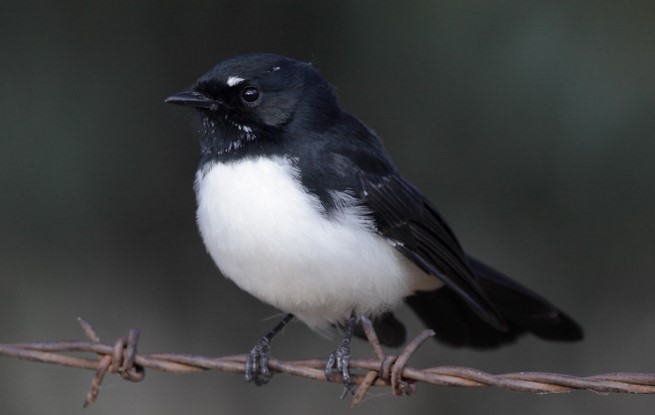Pacific Baza (Aviceda subcristata) is a quiet and unobtrusive treetop hunter in the family Accipitridae. It is also known as the Crested Hawk and Pacific Lizard-Hawk. The Pacific baza can be found throughout Australasia’s warmer and more humid regions. There are breeding populations in Australia, Indonesia, Papua New Guinea, the Solomon Islands, and South Africa, as well as residents in East Timor.
The Pacific Baza lives along the edges of eucalyptus and rainforest, particularly in the galleries of trees along watercourses. Their food sources include grubs, frogs, and reptiles, but their major food source is large stick insects (Phasmatidae), which they hunt on the outer foliage around tree crowns. Occasionally, they crash into foliage, possibly to disturb prey; or they hang upside down on branches, looking for food. There have even been instances of birds catching insects in midair, somersaulting and wheeling to take them.

The Pacific Baza flies slowly and leisurely with broad, rounded wings, allowing them to maneuver acrobatically and easily. During the day, Pacific Bazas hunt at all times, but they are most active in the mornings and later in the afternoons. Bazas are rather solitary birds, although they rarely gather in groups larger than nine; despite being sedentary birds and permanently paired, they only consort closely with their mates during the breeding season.
The nesting process is accompanied by spectacular aerial displays. In addition to soaring and circling regularly to substantial heights, the pair also swoops and tumbles while calling loudly. The birds then undulate excessively in flight, plunging down then rising with vigorous flapping and somersaulting and rolling in midair. Nest building, incubation, brooding, and feeding of young are shared by males and females. The two species defend each other’s nests by raising their crests in response to threats or swooping in response to attacks. In the early stages of the nest’s development, the female spends much time watching the young while the male hunts. Aside from bringing fresh eucalypt leaves to the nest, she cleans away all refuse and intercepts food brought by the male, dismembering it and passing it to the young.
When it comes to identifying male birds, their upper parts are a dark grey-blue, tinged brown on the back and shoulders; their heads are darker; their faces are lighter; and their crests are black. The wings are broad and rounded; the flight feathers are mid to dark blue-grey above, paler below, with darker bars. The tail is dark blue-grey above, paler below, with a dusky bar near the tip. It has a mid-grey throat and upper breast, and a lighter chin. The belly is white to cream with distinct black-brown bars; the vent and undertail coverts are rufous. A golden yellow eye is surrounded by yellow-green skin with a blue tinge. The bill is black above, with a two-notched hook, the lower mandible is blue-grey with a black tip, and the cere and gape are blue-gray. Pale grey feet; dusky claws.
Female Pacific Bazas are browner except for their crowns, mantles, and rumps. The throat is slightly whiter; the upper breasts are lighter grey, sometimes tinged with cinnamon. Breast bars are chestnut-brown; vent and underwing coverts are light rufous; tail has a narrow subterminal bar.
Immature birds have a dark brown head, black crest, brown and grey back, and rufous-edged feathers. The tail is silver-grey below with four distinct dark bars. The chin is white; the throat and upper breast are mottled light rufous, tinged with grey-blue. The belly is rufous cream with narrower bars than in adults; the crissum is sandy. Light yellow eyes. The cere is yellow-green to grey in color. Young downy birds are white.
Pacific Baza call is a hoarsely whistled double call wee-choo or ee-chu, commonly heard during breeding months. Moreover, other calls include double note ke-i, ki-i or ki-o, ki-o, and short whistles and trills.
Read More – New Britain Sparrowhawk (Accipiter brachyurus)

Breeding and nesting occur between September and March, usually between October and December. Nest consists of a flimsy, slightly cupped structure of sticks, lined with twigs and a layer of green leaves, 280-380 mm across, 130-200 mm deep; egg cavity 130-150 mm across, 30-50 mm deep; available for use all year round. It is usually found on a horizontal branch 15-30 meters above ground, rarely lower. Eggs: two or three, rarely five; rough to fine texture with a faint sheen; plain white with a blue tinge, sometimes stained; round-oval, about 43 x 34 mm. The incubation period is about -3233 days, for both sexes. Young will fledge in 33-35 days.
The Pacific Baza measures 360-430mm in length, with females having longer tails than males. Pacific Baza is found in coastal northwestern Australia from Fitzroy River to McArthur River, NT, possibly around the Gulf of Carpentaria. It is also found east of the Cape York Peninsula to about 280 km south of Sydney. It is also found inland to the western fringes of the Great Dividing Range. Also occurs from the Moluccas through to the Lesser Sunda Islands and in New Guinea and adjacent islands to the Solomons. About 12 races, one in Australia. Northwestern Australian populations are slightly smaller than in the east.
Read More – Common Hawk-cuckoo Call







